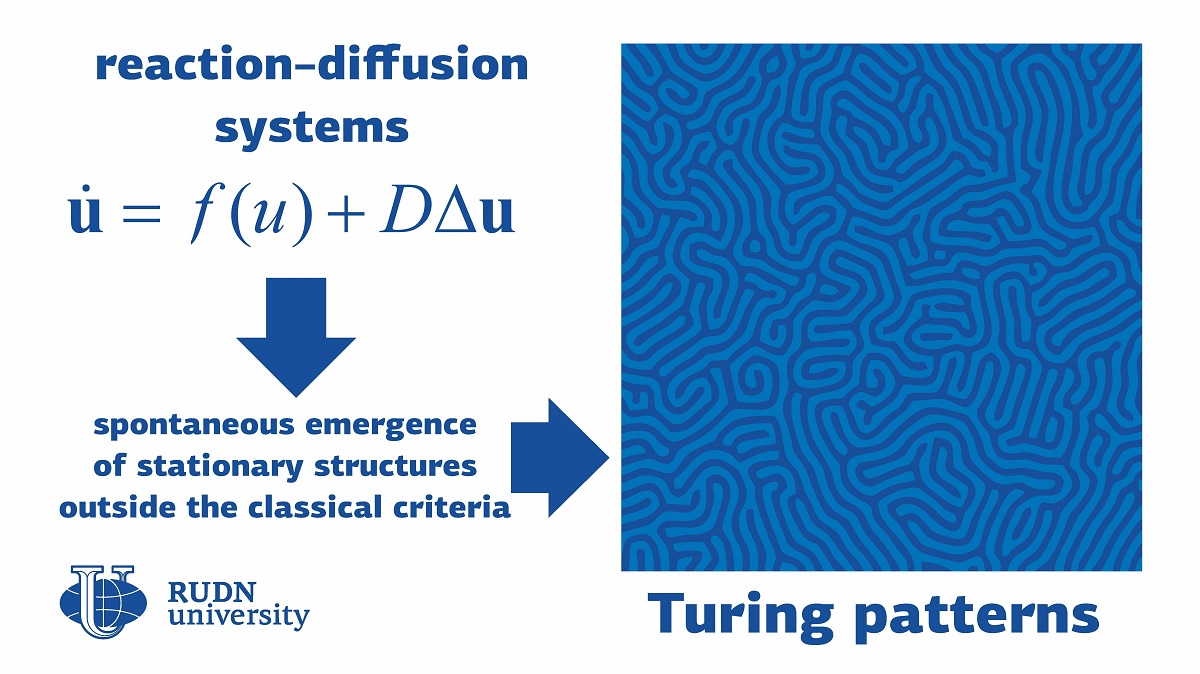Mathematicians specify the criteria for the emergence of Turing patterns

Turing patterns are stable structures that emerge in chemical and biological systems, such as leaves of trees, tentacles of animals, or spots on animal skin, all situated at a given distance from one another. The existence of such patterns was predicted by the British mathematician Alan Turing in 1952. Mathematically, these structures are described by a system of reaction-diffusion equations with two or more interacting elements. The team of mathematicians from RUDN University widened the range of common criteria for the emergence of these patterns in reaction-diffusion systems.
According to Turing's standard model, a system of two elements requires certain conditions for the patterns to emerge. One of the elements should self-activate, i.e., stimulate its own further growth. The second element should self-inhibit, that is, continuously reduce its own activity. Moreover, the mobility (or diffusion coefficient) of the latter should be higher than that of the former to a degree that depends on the values of other systemic parameters. However, this is not true for real-life chemical and biological systems, where the difference between the mobility of the activator and the inhibitor is usually very little. Therefore, there is only a narrow range of values that other systemic parameters can have for the structures to be formed.
"The mechanism suggested by Turing is unstable: The slightest accidental change of model parameters can prevent the structures from forming, and an animal will have no skin patterns or certain organs. However, some recent works indicate that in multi-component systems Turing patterns can form in violation of the common concepts. Namely, studies confirmed the existence of systems with one immobile element in which Turing patterns emerge regardless of the diffusion coefficients of the mobile ones," said Maxim Kuznetsov, Ph.D. and a junior researcher at the Center for Mathematical Modeling in Biomedicine, RUDN University.
According to the team, if a system contains an immobile element (neither a self-activator nor a self-inhibitor), the range of criteria for the emergence of Turing patterns widens considerably. The nature of the interaction between the immobile and mobile elements starts to play a key role in the process. There are three possible types of such interaction: an increase in the concentration of one element can stimulate the growth of the other, inhibit it, or have no effect on it at all. In certain interaction schemes, Turing patterns form regardless not only of mobile element diffusion coefficients but also of the values of other systemic parameters.
"These criteria provide for a considerably complex but more stable mechanism of the formation of Turing patterns. While the reaction speed in biology can vary widely, the types of relations between elements are usually strictly fixed. It is yet unknown whether this mechanism works in natural systems, but all its conditions are in line with the laws of biology. Moreover, given the fact that the development of life is subject to the laws of evolution, this mechanism is likely to be widely spread in nature due to its high stability," added Maxim Kuznetsov.
The results of the study were published in Chaos: An Interdisciplinary Journal of Nonlinear Science.
RUDN summarized the results of the scientific competition "Project Start: work of the science club ". Students of the Faculty of Physics, Mathematics and Natural Sciences have created a project for a managed queuing system using a neural network to redistribute resources between 5G segments. How to increase flexibility, make the network fast and inexpensive and reach more users — tell Gebrial Ibram Esam Zekri ("Fundamental Computer Science and Information Technology", Master's degree, II course) and Ksenia Leontieva ("Applied Mathematics and Computer Science", Master's degree, I course).
The National Demographic Report, 2023 Demographic Well-Being of Russian Regions (hereinafter - the National Demographic Report) was prepared by the scientific team of the Institute of Demographic Studies of the Federal Research Center of the Russian Academy of Sciences, the Vologda Scientific Center of the Russian Academy of Sciences, Peoples' Friendship University of Russia, the Center for Family and Demography of the Academy of Sciences of the Republic of Tatarstan, as well as with the participation of leading scientists from the Republic of Bashkortostan, Stavropol Krai, Volgograd, Ivanovo, Kaliningrad, Nizhny Novgorod, Sverdlovsk Oblasts and Khanty-Mansi Autonomous Okrug–Yugra.
RUDN summarized the results of the scientific competition "Project Start: work of the science club ". Students of the Faculty of Physics, Mathematics and Natural Sciences have created a project for a managed queuing system using a neural network to redistribute resources between 5G segments. How to increase flexibility, make the network fast and inexpensive and reach more users — tell Gebrial Ibram Esam Zekri ("Fundamental Computer Science and Information Technology", Master's degree, II course) and Ksenia Leontieva ("Applied Mathematics and Computer Science", Master's degree, I course).
What is your first association with the word “laboratory”? Flasks and beakers? Microscopes and centrifuges? Yes, many of us would answer the same way.
The National Demographic Report, 2023 Demographic Well-Being of Russian Regions (hereinafter - the National Demographic Report) was prepared by the scientific team of the Institute of Demographic Studies of the Federal Research Center of the Russian Academy of Sciences, the Vologda Scientific Center of the Russian Academy of Sciences, Peoples' Friendship University of Russia, the Center for Family and Demography of the Academy of Sciences of the Republic of Tatarstan, as well as with the participation of leading scientists from the Republic of Bashkortostan, Stavropol Krai, Volgograd, Ivanovo, Kaliningrad, Nizhny Novgorod, Sverdlovsk Oblasts and Khanty-Mansi Autonomous Okrug–Yugra.